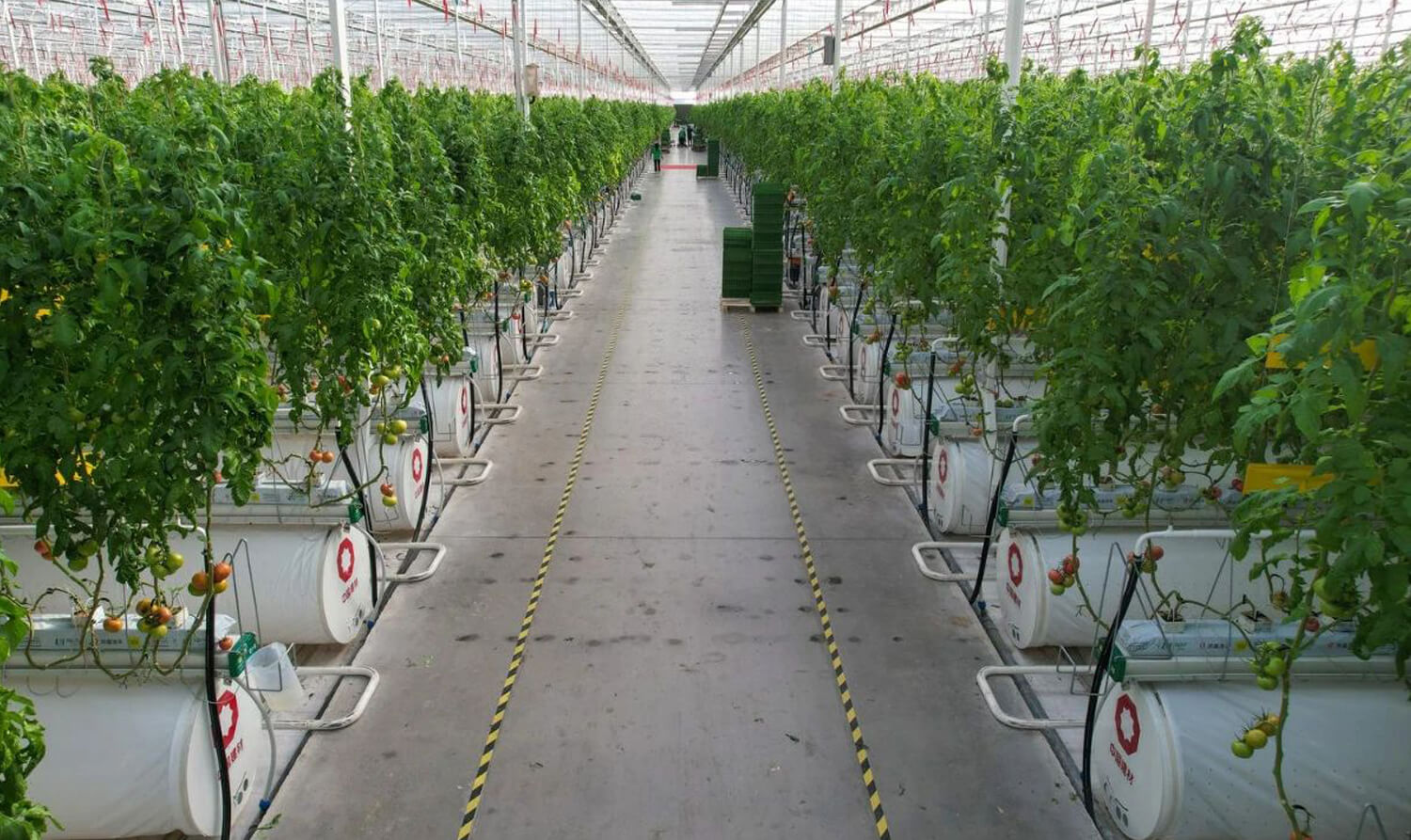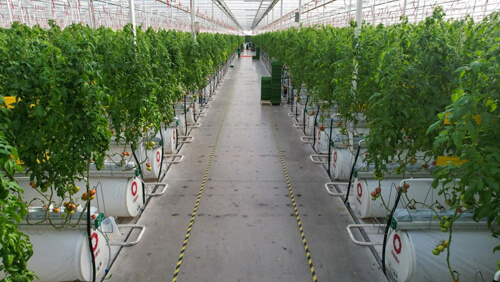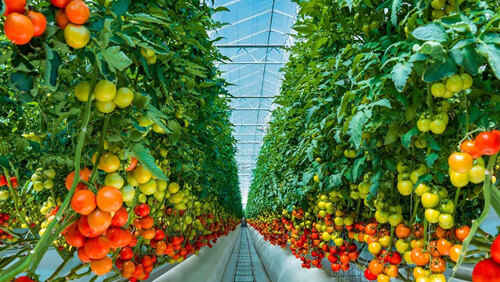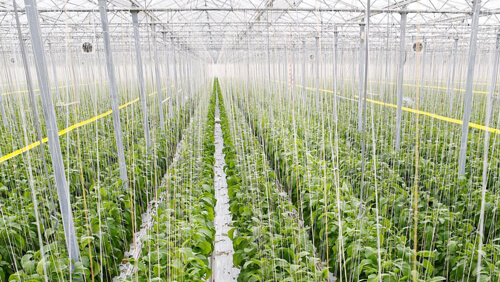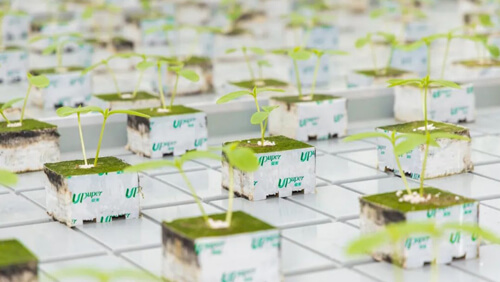The output per square meter reaches 70 kg? Decipher the reason for the high yield of tomatoes in Dutch smart greenhouses! Views: 1882
The Netherlands is a big agricultural country,and the factory planting of intelligent greenhouses is quite developed. There are more than 5,000 hectares of glass intelligent greenhouses used for vegetable production in the country, among which the total production area of tomato, sweet pepper, and cucumber accounts for 30% of the national vegetable planting area, more than 85%. Most of the vegetables produced are mainly exported, which has created huge economic benefits for the Netherlands. Therefore, the development of Dutch agriculture represents the vane of global modern agricultural development.
Technical characteristics of tomato production
Among all exported crops, Dutch tomato production has long been in the leading position in the world. The average annual yield of large-fruited tomatoes can reach 75kg/㎡ without artificial lighting, and over 90kg/㎡ with artificial lighting.
Compared with traditional tomato cultivation, Dutch tomato production technology has the following five characteristics:
01
Selected species
Excellent varieties are the guarantee of high yield. Tomatoes grown in Dutch greenhouses are generally indeterminate. During the year, the tomato plants will not cap and the terminal buds will continue to grow indefinitely. This has just ensured that fruit production is not stopped, and the fruit can be produced uninterruptedly within a year. As a result, the total output can be improved to a certain extent. Ordinary tomato seedlings have been transformed into lush tomato forests here.
02
seedling cultivation
Tomato cultivation in the Netherlands generally uses professional seedling companies to cultivate specific seedlings according to the needs of growers. The seedlings are not cultivated in the soil, but directly on rock wool blocks or coconut peat blocks.
Rock wool has very low chemical activity. After being made into a strip matrix, it can also retain a large amount of water. The grower injects nutrients and water into the rock wool matrix through precise drip irrigation at regular intervals, and then absorbed by the tomato seedlings. When planting, the rock wool blocks with seedlings can be directly placed on the rock wool strips with openings, saving time and labour.
03
Hydroponic cultivation
Dutch tomato production adopts hydroponic cultivation technology. The main cultivation medium is rock wool or coconut bran, which can effectively avoid the external environment and soil pathogenic bacteria and pests from infecting crops. There are no parasite eggs, heavy metals, and chemical harmful substances in soil cultivation. and other pollution risks. Combined with water and fertilizer integration technology, the closed nutrient solution circulation system is used for watering and fertilization, and the resource utilization rate is extremely high. After planting, rock wool and coco peat can also be processed without pollution, which will not cause a negative impact on the environment.
04
long season cultivation
Holland tomatoes produce only 1 crop per year. In order to avoid the impact of low temperature and less sunshine in winter, most farms raise seedlings in winter, planting around December, and finishing planting in mid-to-late November of the following year. The average annual production time can reach more than 48 weeks so that tomato plants can grow as much as possible throughout the year, which is also an important condition for maximizing yield.
05
Fine management of plants
Dutch greenhouse growers regard plants as their own children, and have clear plans for plant adjustments according to different growth stages, so as to create an ideal environment for fruit growth as much as possible.
According to the growth characteristics of tomatoes, plant adjustment is divided into hanging vines, threshing leaves, dropping seedlings, and harvesting. All workload and work quality are counted by the labour management system. Operators are paid according to their workload. When there is a problem with the work quality, and the corresponding workers will be held accountable according to the system records.
(1) hanging vine
Holland tomatoes are generally cultivated with high seedlings and hanging vines. On the one hand, it facilitates the daily operation of workers, and on the other hand, it also improves the ventilation and light transmission conditions at the bottom, which is conducive to achieving high production. Wrapping the top buds of the tomatoes around the twine ensures that the plant continues to grow upwards.
(2) around seedlings
Wrapping seedlings can slightly cause internal damage to the stalk, thereby promoting flowering and fruiting (reproductive growth). While winding the seedlings, remove all the side buds and branches from the leaf axils to avoid nutrient consumption and mutual shading between plants, and finally remove the redundant flowers and front branches .
(3) Drop seedlings
Unlimited-growing tomatoes can grow infinitely taller, but the greenhouse cannot be infinitely taller. When the plants are too tall, workers cannot work even with picking trucks, so it is necessary to lower the hoisted tomatoes to provide growth space.
(4) threshing leaves
For leaf beating, a special leaf-beating knife should be used to remove the leaves, close to the petiole and detachment layer, and remove 2-3 pieces at a time to improve the ventilation and light transmission conditions in the middle and lower parts of the plant and reduce nutrient loss.
(5) Harvesting
Holland tomato harvesting is carried out by workers on automatic track harvesting vehicles that can be raised and lowered, which is fast and efficient and improves picking efficiency. At the same time, harvesting and boxing are also completed at one time, saving manpower.



